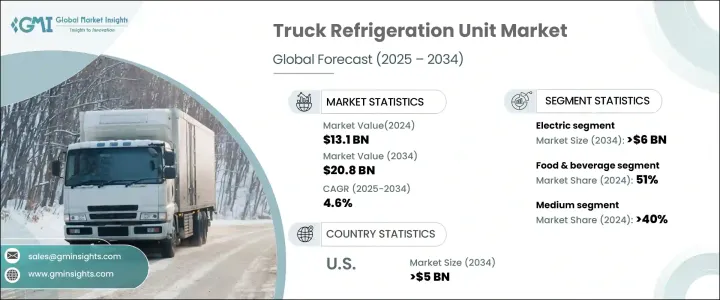
세계의 트럭용 냉동 유닛 시장은 2024년에 131억 달러로 평가되었으며, 2025-2034년 연평균 복합 성장률(CAGR) 4.6%로 확대될 것으로 예측됩니다.
이 성장을 이끌어내는 것은 제품의 품질과 안전성을 확보하는 효율적인 운송 솔루션에 대한 수요의 고조입니다. 온도 관리된 물류에 대한 요구의 고조는 특히 식음료, 의약품, 화학품 등의 업계에서 이 확대를 뒷받침하는 중요한 요인이 되고 있습니다.

국경을 넘어선 무역이 계속 활발해지고 전자상거래 플랫폼이 그 범위를 확대함에 따라 기업은 혁신적인 냉동 기술에 많은 투자를 하고 있습니다. 이러한 진보는 공급망의 효율을 향상시키면서 신선품의 무결성을 유지하는 데 도움이 되고 있습니다. 세계 각국의 정부가 민감한 제품에 대해 엄격한 온도 관리 가이드 라인을 도입하고 있기 때문에 규제 준수도 큰 추진력이 되고 있습니다. 기업은 이러한 기준을 충족하고 성능을 최적화하기 위해 최첨단 솔루션을 통합하고 있습니다. 기업들이 배출량을 줄이고 에너지 효율을 높이기 위해 친환경 대체 수단을 찾고 있기 때문에 지속 가능성도 시장을 재구축하고 있습니다. 제조사는 장기적인 지속 가능성과 운영 비용 절감에 중점을 두고 있으며, 전기식 및 하이브리드식 냉동 유닛이 인기를 끌고 있습니다.
| 시장 범위 | |
|---|---|
| 시작 연도 | 2024년 |
| 예측 연도 | 2025-2034년 |
| 시작 금액 | 131억 달러 |
| 예측 금액 | 208억 달러 |
| CAGR | 4.6% |
시장은 추진유형별로 내연기관(ICE), 전기, 하이브리드 냉동 유닛으로 구분됩니다. ICE 엔진 탑재 시스템은 확립된 인프라, 광범위한 이용 가능성, 장거리 운송에 적합하다는 점 등이 주요 이유로 2024년에는 시장의 45%를 차지했으며 여전히 지배적입니다. 이러한 유닛은 신뢰성 높은 냉각 기능을 제공하기 때문에 대규모 물류 업무에 적합한 선택지가 되고 있습니다. 그러나 업계는 서서히 전동식 냉동 솔루션으로 전환하고 있습니다. 배터리 기술의 진보로 에너지 효율이 개선되어 전기 장치가 점점 더 실행 가능한 선택지가 되고 있습니다. 2034년까지 전동 부문은 60억 달러를 창출할 것으로 예측되고 있으며, 이는 지속 가능한 냉장 옵션에 대한 강한 뒷받침을 반영하고 있습니다.
트럭용 냉동 유닛의 최종 용도는 다양한 산업에 걸쳐 있으며, 식음료 분야가 시장을 선도하고 있습니다. 2024년에는 신선식품, 유제품, 냉동식품, 식육에 대한 수요가 높아지면서 이 분야가 전체 시장 점유율의 51%를 차지했습니다. 신선품의 적절한 온도 관리를 의무화하는 엄격한 규제가 물류 프로바이더에게 고도의 냉각 기술의 채택을 재촉하고 있습니다. 제약업계도 주요 촉진요인으로 2025-2034년 CAGR 6%로 확대될 것으로 예상됩니다. 백신, 생물제제, 온도에 민감한 의약품은 정밀한 냉장 솔루션을 필요로 하기 때문에 특수 콜드체인 로지스틱스에 대한 투자가 증가하고 있습니다.
미국의 트럭용 냉동 유닛 시장은 2024년에 39억 달러를 창출했으며, 2034년에는 50억 달러에 이를 것으로 예측되고 있습니다. 확립된 수송 및 물류망이, 식품 및 의약품 분야로부터의 왕성한 수요와 함께 시장의 확대를 지지하고 있습니다. 지속 가능성에 대한 관심이 높아지는 가운데, 미국의 기업은 효율을 높여 환경에 대한 영향을 최소화하기 위해, 전기식 및 하이브리드식 등의 선진적인 냉동 시스템을 적극적으로 도입하고 있습니다. 지속적인 기술 진보와 보다 환경 친화적인 선택지를 요구하는 규제 당국의 압력에 의해 시장은 향후 몇 년간 큰 변화를 이룰 태세가 갖추어져 있습니다.
The Global Truck Refrigeration Unit Market, valued at USD 13.1 billion in 2024, is projected to expand at a CAGR of 4.6% between 2025 and 2034. The growth is driven by the rising demand for efficient transportation solutions that ensure product quality and security. The increasing need for temperature-controlled logistics is a key factor fueling this expansion, particularly in industries such as food and beverages, pharmaceuticals, and chemicals.

As cross-border trade continues to flourish and e-commerce platforms expand their reach, companies are investing heavily in innovative refrigeration technologies. These advancements help maintain the integrity of perishable goods while improving supply chain efficiency. Regulatory compliance is another major driver, with governments worldwide implementing strict temperature control guidelines for sensitive products. Companies are integrating cutting-edge solutions to meet these standards and optimize performance. Sustainability is also reshaping the market as businesses seek eco-friendly alternatives to reduce emissions and enhance energy efficiency. Electric and hybrid refrigeration units are gaining traction, with manufacturers focusing on long-term sustainability and operational cost reductions.
| Market Scope | |
|---|---|
| Start Year | 2024 |
| Forecast Year | 2025-2034 |
| Start Value | $13.1 Billion |
| Forecast Value | $20.8 Billion |
| CAGR | 4.6% |
The market is segmented by propulsion type into internal combustion engine (ICE), electric, and hybrid refrigeration units. ICE-powered systems remain dominant, accounting for 45% of the market in 2024, largely due to their established infrastructure, widespread availability, and suitability for long-haul transportation. These units offer reliable cooling capabilities, making them the preferred choice for large-scale logistics operations. However, the industry is gradually shifting toward electric-powered refrigeration solutions. Advancements in battery technology are improving energy efficiency, making electric units an increasingly viable alternative. By 2034, the electric segment is projected to generate USD 6 billion, reflecting a strong push toward sustainable refrigeration options.
End-use applications for truck refrigeration units span various industries, with the food and beverage sector leading the market. In 2024, this segment accounted for 51% of the total market share, driven by the rising demand for fresh produce, dairy, frozen foods, and meat. Strict regulations mandating proper temperature control for perishable goods are pushing logistics providers to adopt advanced cooling technologies. The pharmaceutical industry is another major growth driver, expected to expand at a CAGR of 6% between 2025 and 2034. Vaccines, biologics, and temperature-sensitive medications require precise refrigeration solutions, leading to increased investment in specialized cold chain logistics.
The US truck refrigeration unit market generated USD 3.9 billion in 2024 and is projected to reach USD 5 billion by 2034. A well-established transportation and logistics network supports market expansion alongside strong demand from the food and pharmaceutical sectors. As sustainability concerns grow, companies in the US are actively integrating advanced refrigeration systems, including electric and hybrid models, to enhance efficiency and minimize environmental impact. With continuous technological advancements and regulatory pressure for greener alternatives, the market is poised for significant transformation in the coming years.